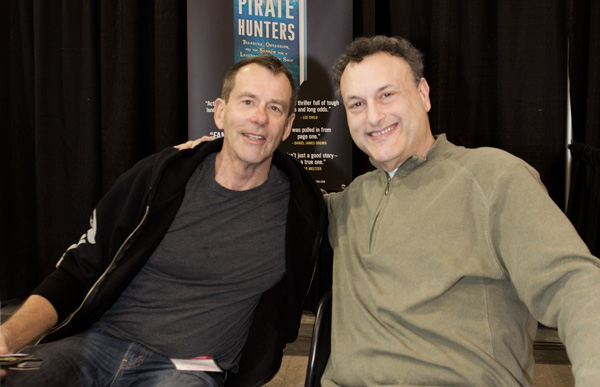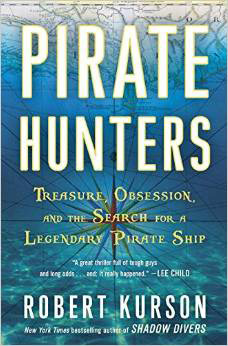For those who have not read the book, ‘Pirate Hunters’ by Robert Kurson is actually two stories in one: first, the story of a well-respected sea captain, Joseph Bannister and how he ‘went rogue’ and made off with one of the ship under his command, the Golden Fleece, to become one of the most wanted pirates of the 17th century. The second story is of how two American divers, John Chatterton and John Mattera, managed to track down and locate this 17th century wreck, using ancient documents and maps, as well as oral legends passed down from generation to generation in the Dominican Republic–once a haven for piracy in the Golden Age of Piracy.
We caught up with John Chatterton recently to ask him about how he came about finding the wreck of the Golden Fleece.
Q: Had you not received the now famous phone call from treasure hunter Tracy Bowen, while you and John Mattera were in the midst of searching for another ship, the San Miguel, do you think you ever would have begun the search for the Golden Fleece?
A: The San Miguel, is a wreck that is rich in history, and holds great potential for valuable and unique artifacts. It was, and still is an incredibly worthy goal. Had we not gone to search for the Golden Fleece, perhaps we would have stayed and found the San Miguel? So many wrecks, so little time, is not a bad problem to have. I still want to go and find the San Miguel. On the other hand, The Golden Fleece was part of local legend where we were living in Samaná. It was a legitimate pirate wreck, and it was definitely on our list.
We had no shortage of sites to work. Why one particular wreck, and not another? All wrecks are unique, and any wreck that has yet to be found is an irresistible mystery. A pirate ship, with numerous failed attempts to find her, was attractive in many ways. We did not need much prodding, and Bowden’s call did just that, but it was also a challenge. Bowden’s call challenged us on a very personal level. He had looked for the wreck for years and failed, as did many others, now he was coming to us.
Q: Many people have romantic notions about pirates and the treasures they supposedly left behind or were carrying at the time their ship sank, but the fact is that the life of a treasure hunter is very often a lot of pain with very little gain, is that not correct? You can go literally decades without finding a single trace of a sunken wreck, while going personally bankrupt in the process. What keeps you going?
A: Writers write, painters paint, and divers dive. I am a diver. It is how I define myself, and I take both my successes and failures personally. I don’t turn my back on financial success, but that is not why I do what I do. Every project is an opportunity to make of it what I can, it is about expression. I enjoy the complexities, the challenges, and the risk.
Q: And for those who may not yet have read the book, ‘Pirate Hunters,’ by Robert Kurson, the Golden Fleece captain, Joseph Bannister was no ordinary pirate either. He was a well-respected merchant captain in the mid-17th century and was making transatlantic voyages, delivering goods on the profitable route between London and Jamaica until he ‘went rogue’ and made off the Golden Fleece and all its cargo and began his career as a pirate, based in Port Royal, Jamaica. He ended his career with an unprecedented battle at sea with two Royal Navy ships who outgunned him–and won.
Do you have any speculation as to why a sea captain with a perfectly good career ahead of him as a merchant captain would have done something like this?
A: Bannister is a fascinating character, living in an incredibly interesting historical context. As you say, he turned his back on a promising career as a merchant captain, and turned to piracy. But his world was one of monarchs, slavery, oppression, injustice, and often hopelessness for those not born to wealth and privilege. The pirates raged against the status quo. It was not about money, it was about freedom for individuals with few other choices in life.
Pirate ships were true democracies. The captain of a pirate ship served his crew at their discretion, and the crew free to stay and serve that captain, or leave as they felt best. I see Bannister as a man who chose to be a free, in a world of institutional oppression and gross injustice. Was piracy any more brutal or violent than slavery, debtor’s prisons, or conscription? Perhaps the smart thing would have been to do a good job, bow to authority, ignore all the injustices of the world, and play the game. Bannister the man, needed to be something different. For me, I would have a hard time coming up with a more interesting historical character.
John Taylor was an Englishman who traveled to the New World in 1686 aboard the merchant ship, St. George. He was a writer, whose manuscript about his adventures is one of the few surviving first person documents to give us real insight into what life was like in Jamaica in the late 17th Century. He claimed to have been aboard the HMS Falcon, during the battle with Bannister and his crew and he details the engagement with words and a drawing of the scene.
The manuscript, which is in the National Library of Jamaica, is interesting reading. The merchant ship St George was probably similar to Banister’s Golden Fleece, when it was a merchant ship delivering passengers and goods. Amongst the other cargo, the St George carried convicts from British prisons, as property for sale in the new world. Their treatment, as described by John Taylor, was brutal. It was slavery. In fact, John Taylor had purchased 3 convicts prior to leaving England, one man and two women, all British, for sale in the New World. Their crimes were minor theft. His profit on the sale of his convicts was $75, not a huge sum and as he noted, less than he expected. It is surprising to me how casually this sort of enterprise was accepted, at least by those doing the buying and selling.
This was Bannister’s world. The things that John Taylor wrote about, were what merchant ship captains would witness on every journey. It was man’s inhumanity to man, as commerce. It was the business of injustice, oppression, and raw brutality. Was this world better than the one he found as a pirate? We have no evidence as to what Bannister was thinking, but these are the realities of his day, and offer a possible explanation for why his promising career may have been something less, and why he embraced the pirate life.
Q: So it would seem that the main key in your search for the Golden fleece was to find a hidden cove on an island on the north side of the Dominican Republic, where Bannister would have careened his ship in a location that was not visible from to warships from the British Navy that were hunting him (careening refers to a method used by 17th century sea captains to beach their ships at high tide in a shallow cove, in such a manner that when the tide went out, it would expose one side of the ship for cleaning and repairs). Really, all you knew at the time was basically that and the fact that he had scuttled the ship in 24 ft. of water. That’s not much to go on. Yet you found it.
A: The historical record told us that the battle between Bannister and the Royal Navy took place on Cayo Levantado, in Bahia Samaná. In the Napoleonic era, the French called the island, both Pirate Island, and Bannister Island. The historical record told us exactly where the wreck was, Cayo Levantado, and that was where everyone had looked, without success. The reason that the wreck had not been found was that everyone had blindly accepted the false interpretation of the historical record, which had been wrong for hundreds of years. The more research we did into Bannister, the more respect we had for his abilities, intelligence, and insights. That convinced us that the history as we knew it, was wrong. Once we accepted that conclusion, we started to think in terms of, what would Bannister have done, it was relatively easy. The key to finding the wreck was understanding both the history, and Bannister.
Q: For many years it was thought that the Golden Fleece might be the previously dived nearby ‘Sugar Wreck’. What led you to the conclusion that they were different wrecks?
A: The sugar wreck was not in the right depth, or location for careening, but it did seem to match the period. The success of pirates was determined by their ability to overtake their prey, which made having a clean fast hull, and careening, very important. In addition, the artifacts that came up from the Sugar Wreck seemed to be those of a merchant ship, not a pirate ship. The artifacts that came up from the Golden Fleece were markedly different.
Q: So, let’s talk about what you found on the Golden Fleece: muskets, cannonballs with the ‘Forward Arrow’ symbol of the British Royal Navy on them, pirate dice carved from bone, pieces of silver and even a cereal bowl with uneaten porridge in it. How on earth did uneaten porridge survive being underwater for over 300 years?
A: You need a scientist to figure that one out? The preservative factors of silt, sediment, fresh water are variable. When sand and silt cover a wreck, or cover artifacts, we end up with things surviving that we never would have expected. That is part of the fun of recovering artifacts from a site. You never know what you will find.
Q: International salvage law is complex and deciding who gets credit for what discovery even more complicated. We know you didn’t get rich from this. In the end, was it all worth it?
A: Well, if I was doing it for the money, or the credit, I probably would not be doing what I do. I would have gone to law school.
Story by Mike Bear.
Special thanks to John Chatterton for this interview.


